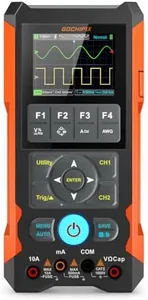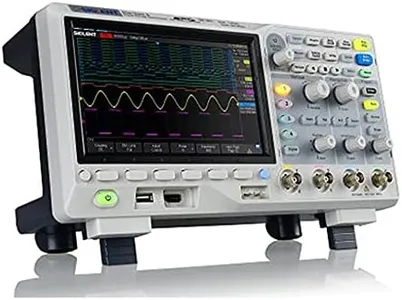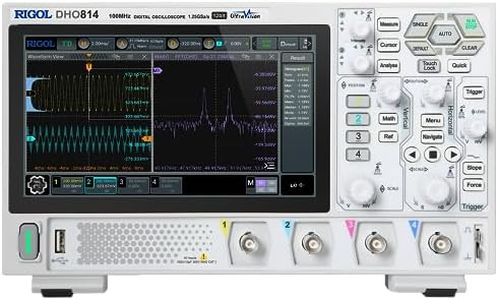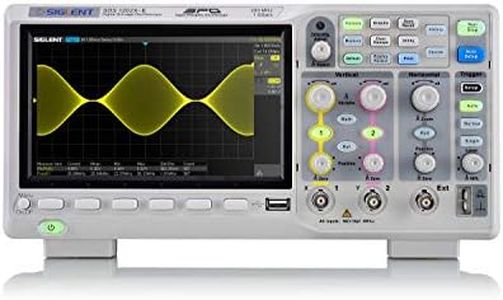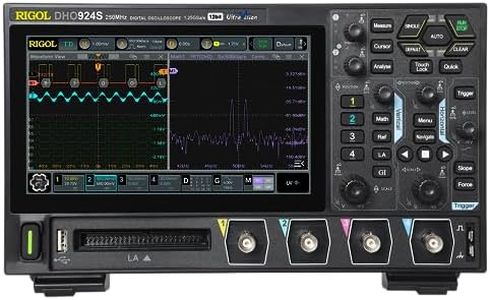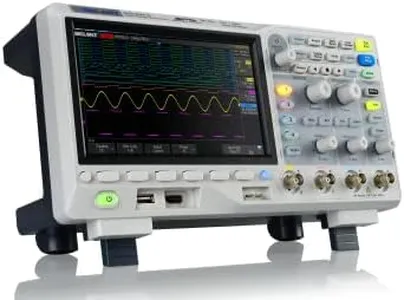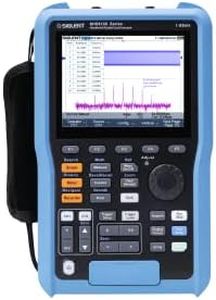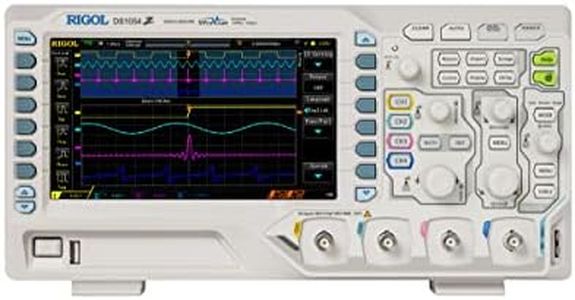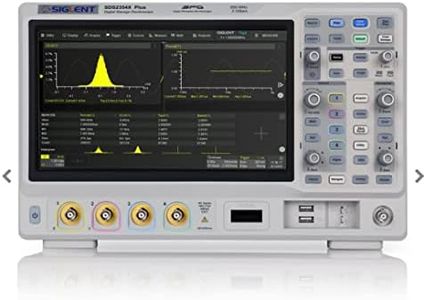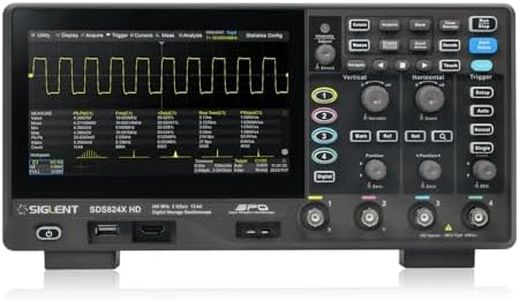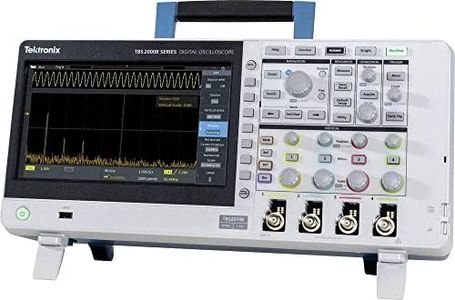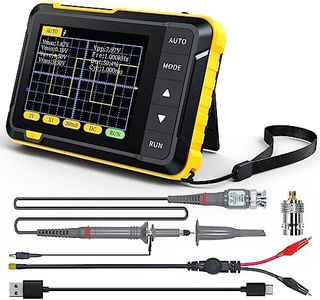10 Best Digital Oscilloscopes 2025 in the United States
Our technology thoroughly searches through the online shopping world, reviewing hundreds of sites. We then process and analyze this information, updating in real-time to bring you the latest top-rated products. This way, you always get the best and most current options available.

Our Top Picks
Winner
Rigol DS1104Z-S Plus Digital Oscilloscope 100Mhz Bandwidth,4 Channels,1GSa/s Sampling Rate,24Mpts Memory Depth,16 Digital Channels,Built-in 25MHz Function/Arbitrary Waveform Generator
Most important from
33 reviews
The Rigol DS1104Z-S Plus Digital Oscilloscope is a versatile tool designed for those needing detailed signal analysis. With a bandwidth of 100 MHz and a sample rate of 1 GSa/sec, it captures fast and complex waveforms effectively. The oscilloscope comes with four analog channels, allowing for simultaneous measurement of multiple signals, which is beneficial for comparing waveforms or analyzing multi-channel circuits.
A significant feature is its 24Mpts memory depth, enabling the capture and analysis of long signal sequences without compromising resolution. This large memory is particularly useful for troubleshooting and signal integrity analysis in complex applications. The inclusion of a built-in 25 MHz function/arbitrary waveform generator adds value by providing signal generation capabilities, which can be handy for testing and debugging purposes without requiring additional equipment.
The device also includes a digital logic connector for optional MSO upgrades, making it future-proof and adaptable to more advanced mixed-signal applications with the purchase of the MSO Upgrade Kit. One notable advantage is the free software bundle included, which enhances the functionality of the oscilloscope with additional tools for analysis and reporting. The Rigol DS1104Z-S Plus is best suited for engineers, technicians, and hobbyists who require a robust and expandable digital oscilloscope for diverse and complex signal analysis tasks.
Most important from
33 reviews
Siglent Technologies SDS1104X-E 100Mhz Digital Oscilloscope 4 Channels Standard Decoder, Grey
Most important from
933 reviews
The Siglent Technologies SDS1104X-E is a solid choice for those looking into digital oscilloscopes, particularly for hobbyists and professionals who need versatile and reliable performance. With a bandwidth of 100 MHz and a decent sample rate, this oscilloscope is equipped to handle a variety of signal measurements. It supports four channels, making it useful for more complex analyses where multiple signals need to be monitored simultaneously. The addition of a standard decoder for protocols like IIC, SPI, UART, CAN, and LIN enhances its functionality, especially in embedded system projects.
One of the standout features is the memory depth, allowing for detailed signal captures, which is essential for analyzing fast signals over time. The display quality is generally good, contributing to a user-friendly experience when interpreting waveforms. Furthermore, with the option for a USB AWG module, it adds even more flexibility for users who may need signal generation capabilities alongside their measurements.
The weight of 6.6 pounds may make it less portable than some users would prefer, particularly for those who might need to transport it frequently. Additionally, while it caters well to common protocols, it may lack specialized decoding for less common protocols, which could be a limitation for some advanced users. The model has been in the market since 2017, so while it remains relevant, it may not have the latest technology features found in newer models.
The SDS1104X-E digital oscilloscope is a well-rounded instrument for those who require a reliable tool for everyday signal analysis in an industrial, scientific, or educational setting. It balances features and performance effectively, although potential users should consider their specific needs, especially regarding portability and protocol decoding capabilities.
Most important from
933 reviews
RIGOL Digital Oscilloscope DHO814 100MHz Frequency Band + 12-bit Vertical Resolution + Maximum 1.25 GSa/s Sample Rate + 1000,000 wfms/s Waveform Capture Rate + 4 Analog Channels + 25 Mpts Maximum Memo
Most important from
113 reviews
The RIGOL Digital Oscilloscope DHO814 is designed for professionals and hobbyists who need reliable performance in a compact package. With a bandwidth of 100 MHz and up to 1.25 GSa/s sample rate, it meets the demands of various applications, from basic electronics to more complex signal analysis. The device's 12-bit vertical resolution enhances the clarity of signals, allowing for better observation of small fluctuations that may otherwise go unnoticed.
One of its standout features is the support for up to four analog channels, enabling users to analyze multiple signals simultaneously, which is a significant advantage in complex diagnostic scenarios. The 25 Mpts memory depth allows for capturing longer signals without losing detail, making it ideal for applications requiring extensive data capture. The user-friendly 7-inch touchscreen display coupled with the innovative Flex knob improves usability significantly, making navigation through options intuitive.
However, there are some drawbacks to consider. While the 100 MHz bandwidth is sufficient for many applications, professionals working with higher frequency signals may find it limiting. Additionally, though the waveform search and navigation functions are beneficial, they may have a learning curve for beginners. There are also some competitors that offer higher specifications at a similar price point, which could be a consideration for users wanting the latest features.
Most important from
113 reviews
Buying Guide for the Best Digital Oscilloscopes
Choosing the right digital oscilloscope can be a daunting task, especially if you're new to the field. A digital oscilloscope is an essential tool for anyone working with electronics, as it allows you to visualize electrical signals and diagnose issues in circuits. To make an informed decision, it's important to understand the key specifications and how they relate to your specific needs. Here are the main specs you should consider when selecting a digital oscilloscope.FAQ
Most Popular Categories Right Now
